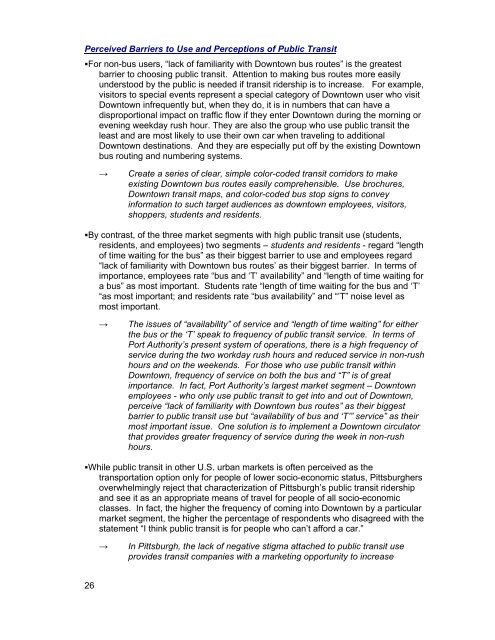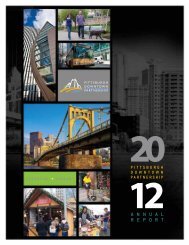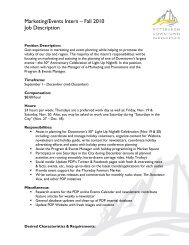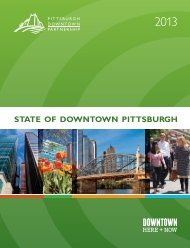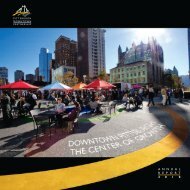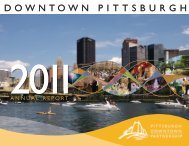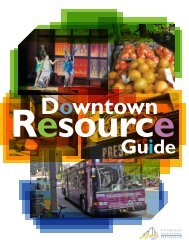Executive Report - The Pittsburgh Downtown Partnership
Executive Report - The Pittsburgh Downtown Partnership
Executive Report - The Pittsburgh Downtown Partnership
Create successful ePaper yourself
Turn your PDF publications into a flip-book with our unique Google optimized e-Paper software.
Perceived Barriers to Use and Perceptions of Public Transit•For non-bus users, “lack of familiarity with <strong>Downtown</strong> bus routes” is the greatestbarrier to choosing public transit. Attention to making bus routes more easilyunderstood by the public is needed if transit ridership is to increase. For example,visitors to special events represent a special category of <strong>Downtown</strong> user who visit<strong>Downtown</strong> infrequently but, when they do, it is in numbers that can have adisproportional impact on traffic flow if they enter <strong>Downtown</strong> during the morning orevening weekday rush hour. <strong>The</strong>y are also the group who use public transit theleast and are most likely to use their own car when traveling to additional<strong>Downtown</strong> destinations. And they are especially put off by the existing <strong>Downtown</strong>bus routing and numbering systems.→Create a series of clear, simple color-coded transit corridors to makeexisting <strong>Downtown</strong> bus routes easily comprehensible. Use brochures,<strong>Downtown</strong> transit maps, and color-coded bus stop signs to conveyinformation to such target audiences as downtown employees, visitors,shoppers, students and residents.•By contrast, of the three market segments with high public transit use (students,residents, and employees) two segments – students and residents - regard “lengthof time waiting for the bus” as their biggest barrier to use and employees regard“lack of familiarity with <strong>Downtown</strong> bus routes’ as their biggest barrier. In terms ofimportance, employees rate “bus and ‘T’ availability” and “length of time waiting fora bus” as most important. Students rate “length of time waiting for the bus and ‘T’“as most important; and residents rate “bus availability” and “’T” noise level asmost important.→<strong>The</strong> issues of “availability” of service and “length of time waiting” for eitherthe bus or the ‘T’ speak to frequency of public transit service. In terms ofPort Authority’s present system of operations, there is a high frequency ofservice during the two workday rush hours and reduced service in non-rushhours and on the weekends. For those who use public transit within<strong>Downtown</strong>, frequency of service on both the bus and “T” is of greatimportance. In fact, Port Authority’s largest market segment – <strong>Downtown</strong>employees - who only use public transit to get into and out of <strong>Downtown</strong>,perceive “lack of familiarity with <strong>Downtown</strong> bus routes” as their biggestbarrier to public transit use but “availability of bus and ‘T’” service” as theirmost important issue. One solution is to implement a <strong>Downtown</strong> circulatorthat provides greater frequency of service during the week in non-rushhours.•While public transit in other U.S. urban markets is often perceived as thetransportation option only for people of lower socio-economic status, <strong>Pittsburgh</strong>ersoverwhelmingly reject that characterization of <strong>Pittsburgh</strong>’s public transit ridershipand see it as an appropriate means of travel for people of all socio-economicclasses. In fact, the higher the frequency of coming into <strong>Downtown</strong> by a particularmarket segment, the higher the percentage of respondents who disagreed with thestatement “I think public transit is for people who can’t afford a car.”→In <strong>Pittsburgh</strong>, the lack of negative stigma attached to public transit useprovides transit companies with a marketing opportunity to increase26


